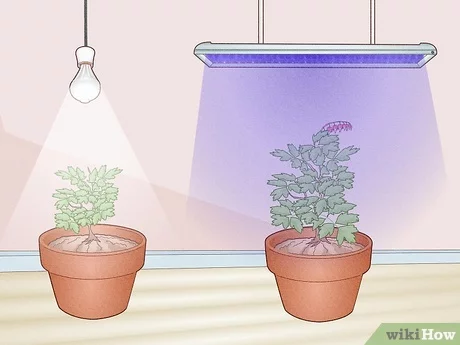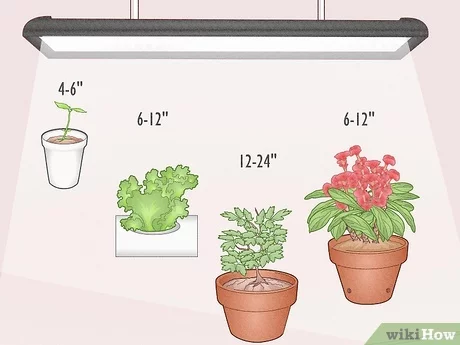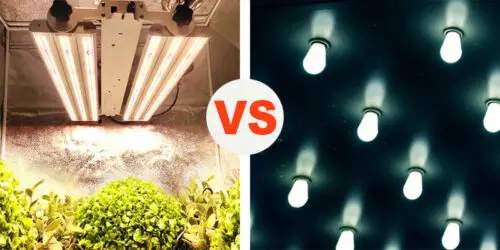A plant light is designed to provide light for indoor plants to aid in their growth, while a grow light is specifically designed to mimic the sunlight spectrum, providing the full range of light wavelengths needed for photosynthesis. Indoor gardening has gained popularity, and many people are now investing in plant lights and grow lights for their indoor plants.
Understanding the difference between the two is crucial for ensuring the healthy growth of your plants. Both types of lights have specific purposes and can greatly impact the overall growth and health of your indoor plants. By understanding the nuances between plant lights and grow lights, you can ensure that your indoor plants receive the appropriate light exposure for their specific needs, facilitating optimal growth and development.
Let’s delve deeper into the distinctions between plant lights and grow lights to shed light on their unique roles in indoor gardening.

Credit: www.wikihow.com
Purpose Of Light
Plants’ Light Requirement
Plants need light to survive and grow.
Light is essential for the process of photosynthesis.
Role Of Plant Light
Plant light is natural sunlight.
It provides the full spectrum of light needed for plant growth.
Role Of Grow Light
Grow light is a man-made light source.
It emits specific wavelengths to stimulate plant growth.

Credit: www.wikihow.com
Light Spectrum
The light spectrum is a crucial factor in understanding the difference between a plant light and a grow light. It influences plant growth, development, and overall health. Let’s dive into the specifics of the light spectrum for plant light and grow light to comprehend their distinctive features and functions.
Plant Light Spectrum
For plants, the light spectrum is a broad range of wavelengths, including visible light and both ultraviolet (UV) and infrared (IR) radiation. Different colors within the spectrum have varying effects on plant growth. Blue light, for instance, promotes vegetative growth, while red light is essential for flowering and fruiting stages. Plant lights are designed to provide a diverse spectrum that mimics natural sunlight, catering to the various needs of plants at different growth stages.
Grow Light Spectrum
Grow lights also consist of diverse wavelengths, but they are customizable to suit specific plant growth requirements. These lights often utilize a combination of red, blue, and sometimes white or UV light to create an optimized spectrum for supporting plant growth in controlled environments. Grow lights offer flexibility in adjusting the spectrum to enhance certain aspects of plant development, such as enhancing resin production or overall yield.
Intensity And Coverage
Intensity and coverage are essential factors to consider when choosing the right plant or grow light for your indoor garden. Understanding the difference in intensity and coverage between these types of lights will help you provide the right conditions for optimal plant growth.
Plant Light Intensity And Coverage
Plant lights are designed to provide a lower intensity of light over a larger area, ensuring even coverage for a variety of plants. They typically emit a balanced spectrum of light that closely resembles natural sunlight, promoting healthy growth for all types of plants.
Grow Light Intensity And Coverage
On the other hand, grow lights produce a higher intensity of light targeted at specific areas, making them ideal for plants that require more concentrated light, such as high-light tropicals or fruiting plants. The coverage area of grow lights is more limited, providing a focused and intense light source for targeted plant growth.

Credit: medicgrow.com
Energy Efficiency
Energy efficiency is an important factor when considering plant lights and grow lights. Understanding the difference between the two can help optimize your indoor gardening setup and save energy in the process.
In terms of Energy Efficiency:Plant Light Efficiency
Plant lights are designed for basic photosynthesis, suitable for houseplants.Grow Light Efficiency
Grow lights emit specific light wavelengths for different growth stages.Cost And Maintenance
Plant lights are designed for aesthetics, enhancing indoor greenery, while grow lights focus on maximizing plant growth. Cost-wise, plant lights are generally more affordable and low-maintenance, ideal for decorative purposes. Grow lights, however, are higher in cost and require more attention for optimal plant development.
Plant Light Cost And Maintenance
When it comes to cost and maintenance, plant lights are often the more affordable option for indoor gardening enthusiasts. Not only are plant lights generally cheaper to purchase upfront, but they also tend to have lower electricity costs compared to grow lights.
Plant lights are designed to provide the necessary light spectrum for optimal plant growth, promoting photosynthesis and healthy plant development. These lights typically come in different types, including fluorescent, LED, and incandescent bulbs. While the initial cost of plant lights may vary depending on the type and brand, they generally require less energy to operate, resulting in lower electricity bills.
In terms of maintenance, plant lights are relatively easy to care for. They have a longer lifespan compared to grow lights, which means you won’t need to replace them as frequently. Additionally, plant lights typically don’t require any specialized equipment or tools for installation or maintenance. A simple wipe down with a clean cloth or mild cleaning solution is usually sufficient to keep them in good condition.
Grow Light Cost And Maintenance
On the other hand, grow lights are specifically designed for professional indoor gardening where larger, more intensive setups are required. While the initial cost of grow lights may be higher compared to plant lights, they offer several advantages that justify the investment.
Firstly, grow lights are designed to emit a higher intensity of light, allowing for better and faster plant growth. This results in higher yields and more productive indoor gardens. However, this increased intensity usually translates to higher electricity consumption, leading to higher electricity bills.
In terms of maintenance, grow lights may require more attention compared to plant lights. The higher intensity of light they produce can result in increased heat, which may necessitate more active cooling or ventilation measures to ensure the optimal temperature for plant growth. Additionally, replacing the bulbs or components of grow lights may be required more frequently due to their higher intensity and the wear and tear associated with extended use.
Frequently Asked Questions For What Is The Difference Between A Plant Light And A Grow Light?
Can You Use Any Light As A Grow Light For Plants?
Yes, you can use certain types of light for plant growth. LED, fluorescent, and HID lights are commonly used as grow lights for indoor plants. These lights provide the necessary spectrum of light for photosynthesis and plant growth. However, standard household lights may not be sufficient for optimal plant growth.
Are Led Lights Grow Lights For Plants?
Yes, LED lights can be used as grow lights for plants. They provide the necessary spectrum for photosynthesis and are energy efficient.
What Is The Best Light For Growing Plants Indoors?
The best light for growing plants indoors is full spectrum LED lights. They provide the right balance of light for optimal plant growth and are energy-efficient.
Is A Daylight Bulb The Same As A Grow Light?
No, a daylight bulb is not the same as a grow light. While a daylight bulb emits light similar to natural sunlight, a grow light is specifically designed to provide the necessary spectrum of light for plants to grow and thrive.
Conclusion
To sum up, understanding the variance between plant lights and grow lights is crucial. Choosing the right one depending on your plant’s needs will determine your garden’s success. Ensure you pick the appropriate light source for optimal plant growth and health.
Make informed decisions for a thriving indoor garden.
